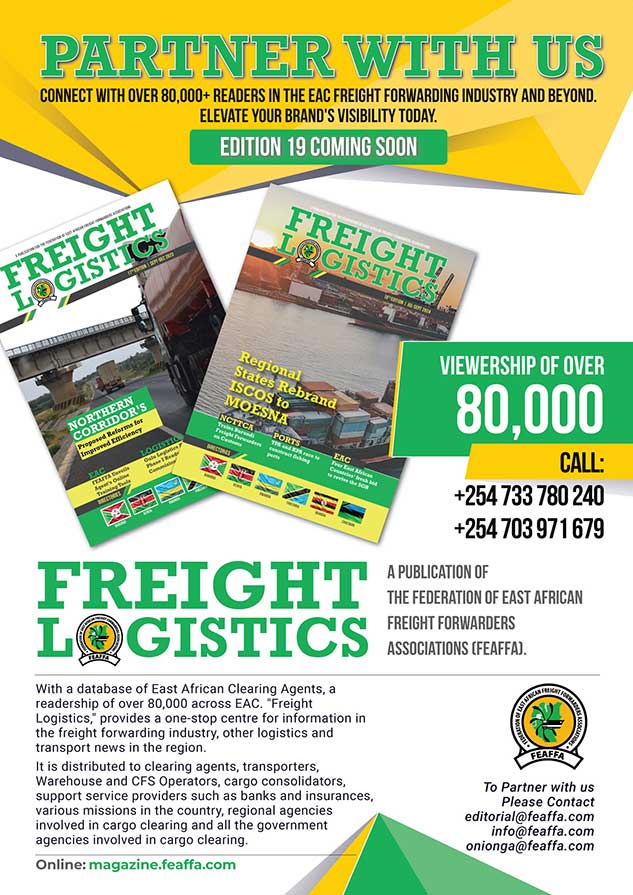The port of Mombasa half yearly cargo throughput has recorded a 5% decline due to Covid 19 pandemic that has slowed down imports. Between January and May 2020, the port handled 13.6 million metric tonnes of cargo compared to 4.3 million metric tonnes in 2019.
During the same period, imports accounted for 82% of the total throughput; suggesting that the balance of trade was unfavourable.
Notably, a larger share of imported cargo through the port of Mombasa for the five months was containerized cargo that stood at 66%. Kenya accounted for the bulk of total throughput at 64%; whereas about 36% of total throughput was for transit market.
Uganda remains the biggest transit market destination for cargo passing through the port of Mombasa; accounting for 3.28 million metric tonnes during the reporting period.
A further decline in imports as a share of throughput from 84% in January 2020 to 80% in May 2020 was witnessed; suggesting reduction in import trade in the countries that uses the port of Mombasa. However, in May 2020, exports accounted for 13% of total the throughput, increasing from 11% in January 2020; indicating a more-hard-hit import trade as opposed to export trade.
The same report showed a decline in the demand for crude oil which may be attributed to the outbreak of the Coronavirus and perhaps the subsequent cut in oil production by oil-producing countries. According to the Oil Market Report, since May 2020, OPEC+ countries have been reducing output by over nine million barrels per day; a factor that undermined the demand for crude oil globally.
Available data indicated that from January to May 2020, a total of 214 ships docked at the port of Mombasa. Notably, the volume of cargo delivered by vessels through the port of Mombasa declined; with average metric tons per ship recorded at 61,598mt in January 2020, further declining to 44,278mt in May 2020.
The report attributed these changes to the reduced global demand and trade and predicts that it will dwindle further in tandem with the shrinking trade volumes occasioned by the reduction in economic activities in all countries due to the COVID-19 pandemic.
The average ship waiting time before berth varied from 36 hours in April 2020to 16 hours in June 2020. Likewise, the average ship turnaround time improved from 111 hours to 75 hours; which may partly be attributed to the initiatives implemented at the port, including the modernization of equipment and expansion of berths.
The Average Container Dwell Time at the Port has seen a steady improvement from 123 hours in April 2020 to 96 hours in June 2020 against a target of 78 hours by December 2020 as per the Mombasa Port and Northern Corridor Community Charter. However, a comparison with the same quarter in 2019 showed an increase in the dwell time for the quarter in 2020. In 2019, the Average Container dwell time ranged between 80 to 88 hours
Statistics also showed that the indicator for the delays after customs release at the port of Mombasa worsened for the quarter in 2020 to a maximum of 51 hours when compared to the same quarter in 2019, which at its highest stood at 38 hours, as truckers experienced long waits for clearance for COVID-19 health protocols before embarking on their journeys. However, there was a gradual improvement in performance for the quarter from 55 hours in April 2020 to 34 hours in June 2020.
Transit time from Mombasa to Kampala varied from 156 hours in January to 185 hours in June 2020. From Mombasa to Kigali, the transit time increased from 167 hours in January to almost twice at 306 hours in the month of June 2020. Mombasa to Elegu increased from 91 hours in January to 179 hours in June 2020.
The report recommends that the Northern Corridor Member States develop policies geared towards addressing the hazards that may occur and disrupt transport and supply chain logistics. Also, the report emphasizes the need for a detailed assessment of regional vulnerability and putting in place country-specific and transboundary disaster mitigation measures.
In a bid to develop resilience and prepare the Transport Corridor to respond to emerging issues, the report, while appreciating ongoing conversations and roadmaps being suggested by the Member States and different stakeholders aimed at facilitating a quick socio-economic recovery, the following proposals may hold: a regional multi-stakeholder response approach where risk factors and disaster risk reduction measures are integrated into both national and regional policies, plans and programmes; and regional and international cooperation in assessing, monitoring and responding to transboundary hazards.





